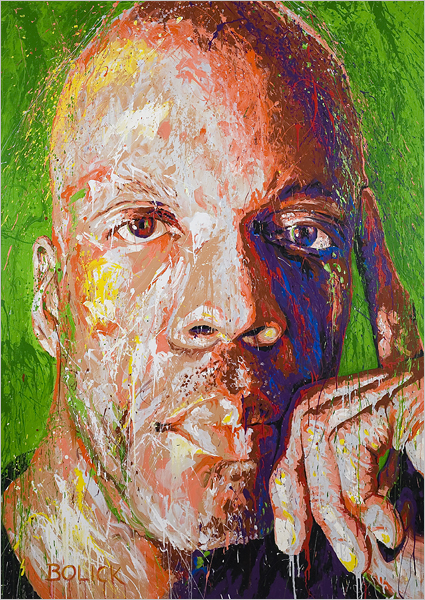
DREW WHITLEY: SENTENCED TO LIFE IN PRISON FOR A MURDER HE DID NOT COMMIT
56" X 78" _ Acrylic, Latex and Spraypaint on Canvas
Drew spent eighteen years in the Pennsylvania State Correctional Institution for a crime he did not commit. Drew was sentenced
to life imprisonment for second degree murder in the 1988 shooting death of Noreen Malloy at a McDonald’s restaurant near Kennywood
Park.
The perpetrator, who wore a trench coat, stocking mask and a felt hat, could not be identified by any of the witnesses.
Police eventually found a witness who said, an hour after Ms. Malloy’s killing, that he looked directly at the assailant from a distance
of three feet but did not know who he was.
Twenty-six hours later, after repeated interrogations, the witness named Drew as the
killer. He said he recognized him by his voice and the way he walked. His story contradicted so much evidence collected
in the aftermath of the Malloy killing that police did not immediately file charges against Drew. Hair and fingerprints collected
at the scene did not match and DNA testing was not available at the time. However, Drew was jailed the next day on a technical parole
violation.
Six months later, Gary Starr, a double murderer on death row said that while in prison Drew had confessed to the Malloy
killing even though penitentiary records show that Mr. Starr was isolated on death row and would not have access to Drew at the prison.
Within a year of Drew’s trial, Mr. Starr’s death sentence was reduced to life in prison.
DNA testing came into widespread use
in the 90s and after a six-year fight Drew was granted DNA testing but police officials said they lost all but two of the hairs found
in the physical evidence from the crime scene. They said the rest of the evidence had been lost in a flood at the County Police
headquarters in the mid 1990s.
In 2003, county police found the missing hair samples. In 2006 DNA profiling proved that
the hair samples did not match Drew Whitley and he was exonerated.
Drew left prison with less than one hundred dollars from working
in the prison laundry.
Since his exoneration, Drew has not had much luck finding work, but is enjoying his freedom.
Convicted: 1988
Exonerated: 2006